Home / Exhibition Review: “Agus Suwage: The Theater of Me”
Share this article:
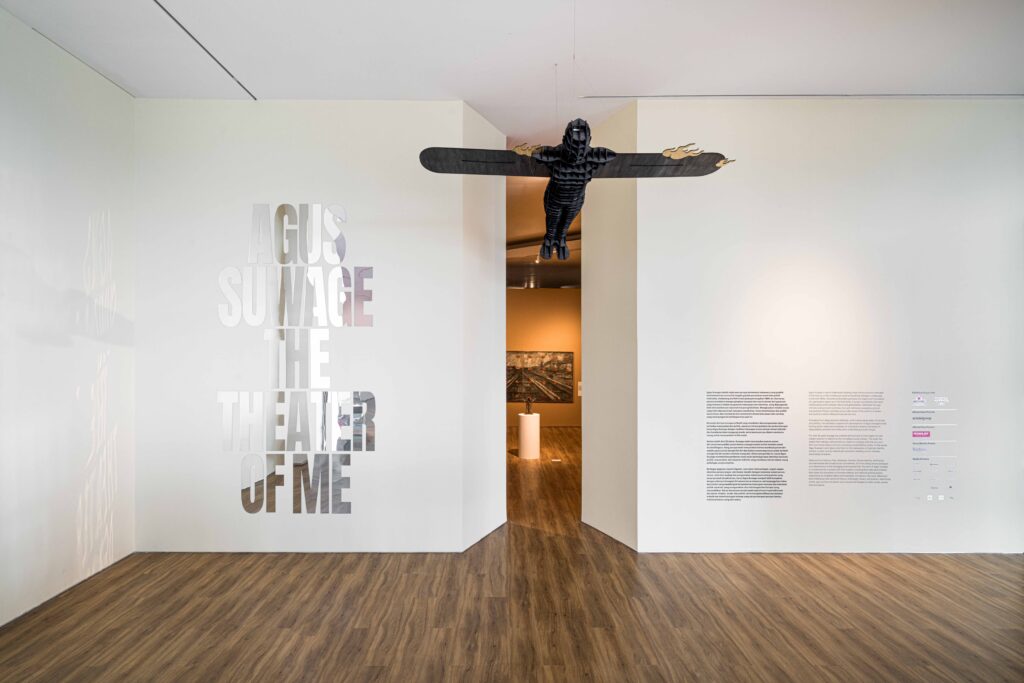
Museum MACAN, Jakarta, Indonesia
4 June – 15 October 2022
Co-curated by Aaron Seeto, Director of Museum MACAN
By Sadiah Boonstra
Agus Suwage (Indonesia, b.1959) has been active for 30 years. With a background in graphic design and communication, his artistic career started in the tumultuous 1990s at the tail end of Suharto’s New Order (1966-1998). Twenty years after Suwage’s first solo-show in 1995 at Cemeti Art House, Yogyakarta, Museum MACAN devotes a large overview exhibition to Suwage’s extensive body of work featuring over 80 artworks including paintings, installations, drawings, sculpture and archival materials curated by MACAN’s director, Aaron Seeto. Suwage’s works in this exhibition invite reminiscence, contemplation, analysis, amazement, puzzlement, laughter and chills.
The exhibition title Agus Suwage: Theatre of Me suggests that the show offers a theatrical perspective of the artist and the world in which he lives. The exhibition leads the visitor through Suwage’s artistic trajectory starting with early works from the politically turbulent era of the 1990s, followed by a large number of self-portraits after which the visitor is led through the artist’s further development from the mid-2000s until the present. The dialectical development and dynamics of the local and the global art scene run as a red thread through all sections, as does a children’s trail and various activities that invite the visitor to personally connect to the artworks on display.
The extensive body of work shows how the artist is politically, socially, economically, and environmentally engaged with both his immediate lived and global environment. Politics, religion, cultural practices across the Indonesian archipelago, pop culture and art history clearly underlie his practice. Suwage’s figurative work is sometimes narrative with many layers that create an unusual and (at times) uncomfortable mix of morbidity, absurdity, and humour suffused with rock and roll. What transpires from this immense oeuvre is an open and pluralistic outlook on the world and life itself, which might result from Suwage’s mixed background as a Javanese-Chinese-Indonesian, who was raised Catholic but converted to Islam before marrying his wife, the artist Titarubi.
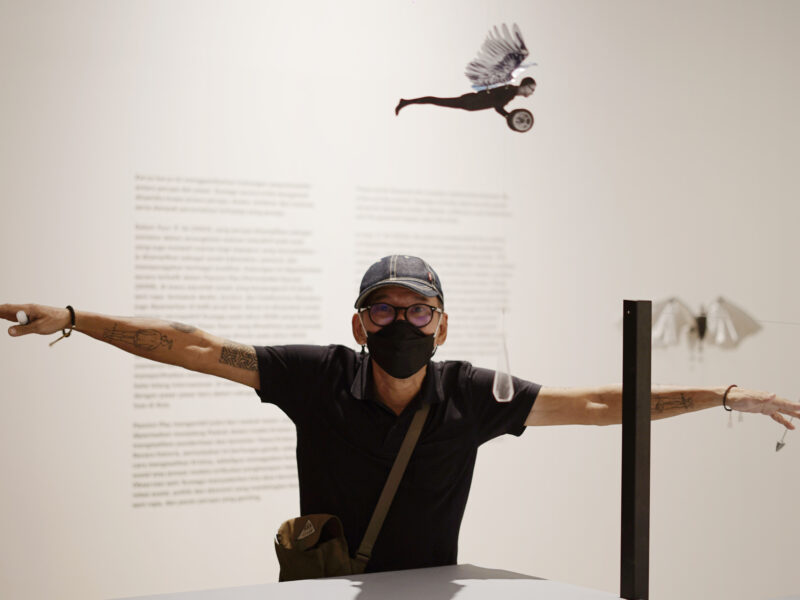
While Suwage’s works do not come across as specifically political, political violence and change informed the context in which he started to create art– a period during which Indonesia transitioned from authoritarian rule to democracy. Arrival, Departure (1995), inspired by Anselm Kiefer (Germany b. 1945) explores how Indonesia’s history can be represented in painting practice. The leaves, attached on the surface of the canvas, are each inscribed with names of assassinated political figures, such as Mahatma Gandhi (1869-1948) and Stephen Biko (1946-1977). The inclusion of figures like the Indonesian political activist Tan Malaka (1897-1949), and labour activist Marsinah (1969-183) suggest that his comment is not only aimed at global politics but also looks inwardly to Indonesian society.
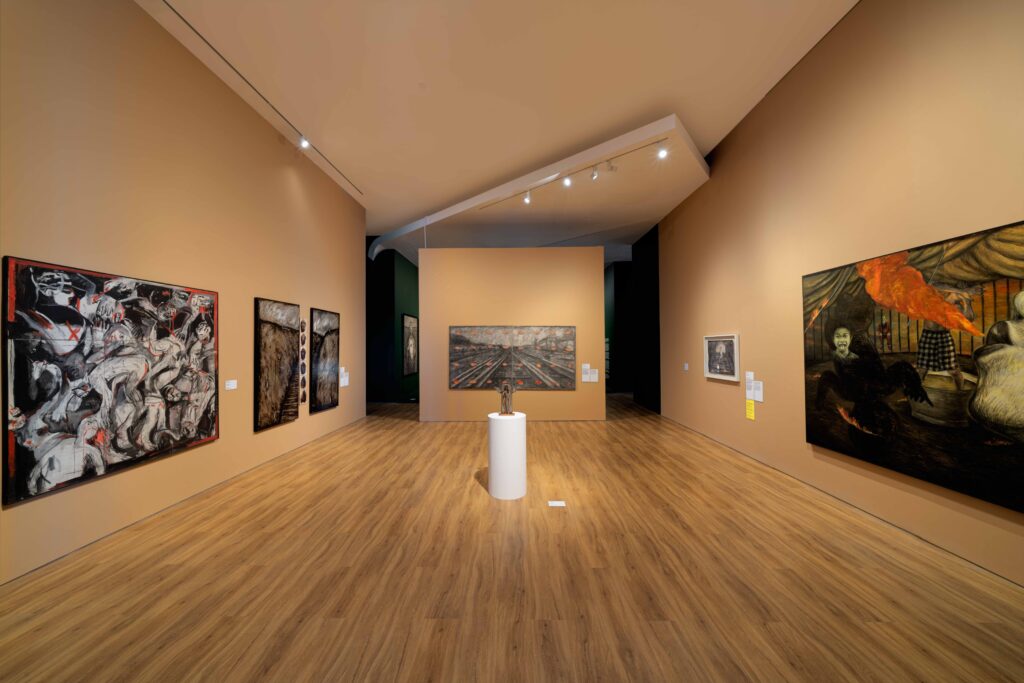
The darkness of the 1990s — the works presented in this section literally make use of dark hues — makes way for a rich production of self-portraits with eclectic imagery. Economically, using his own face saved him the cost of engaging a model, but more importantly and conceptually, Suwage uses his own face for self-critique. His self-portraits are based on pictures that are subsequently painted, a process through which the subject and the object of the painting are the same, as noted by curator Enin Supriyanto. Self-Portrait and the Theatre Stage (Portret Diri dan Panggung Sandiware) (2019), a large installation created during the pandemic and exhibited for the first time, consists of 60 different self-portraits. We see the artist placing a hand before his mouth, or in his ears, and in a surrealistic manner akin to Magritte’s paintings, a flame, a parrot, gas tank and so on, are placed in lieu of his face. The artist uses facial expressions, gestures and postures as a way of expressing ideas. But Suwage’s self-portraits are not just an idea, they are also highly performative, and his canvases capture a frozen moment of a performance through which he conveys his narratives.
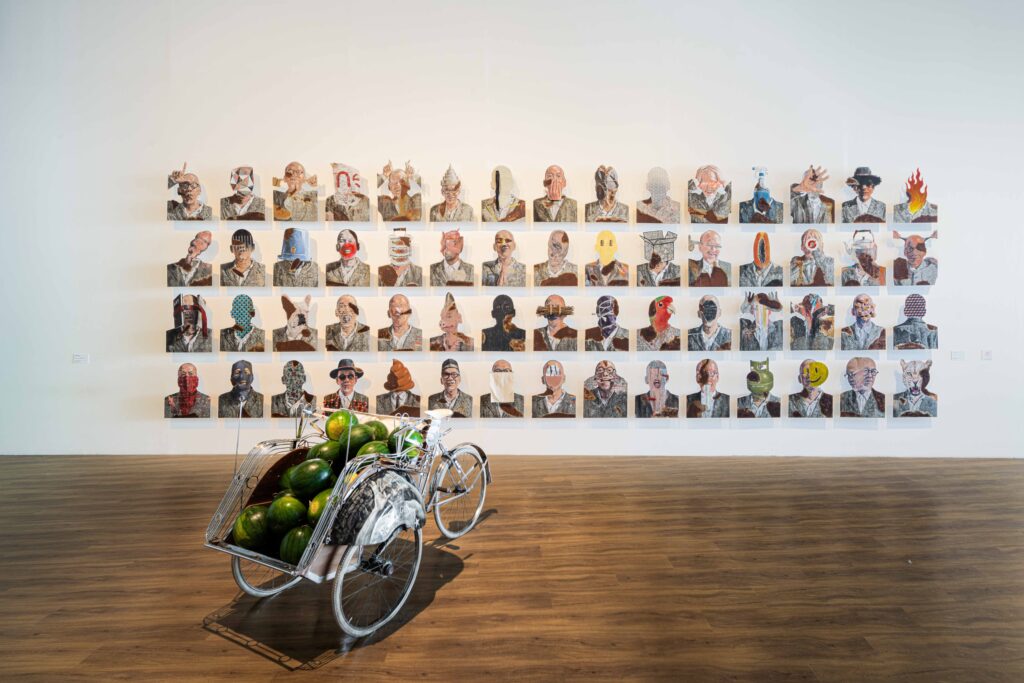
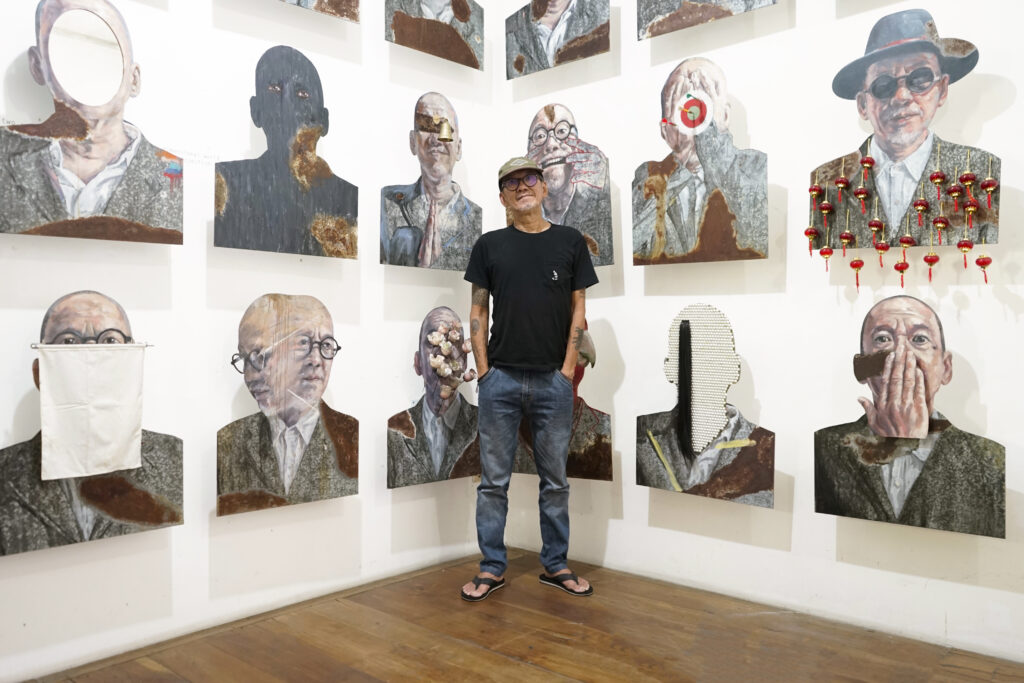
Performance art, women’s performance in feminist art
Recognizing the strong performative aspect of his self-portraiture practice in the early 2000s, Suwage became interested in feminist performance art. Because of the emphasis on self-portraits and the ‘theatre’ of Suwage, the show leans heavily towards a male representation. Since the artist is deeply inspired by women performance artists, it would have been interesting to see this influence on the artist’s practice more pronounced in the exhibition. To Suwage, female performers in the 1960s were more “complete” than male performers because women performers used their own body as a medium for art, to react and protest against authority and regulation. In his view “that’s exactly what needs to be expressed through women’s body, for example, with nudity.”
It was nudity in his collaborative work with Davy Linggar Pinkswing Park (2005) that sparked a heated controversy when it was displayed at the second CP Biennale in Jakarta. The iconic installation features a pink becak (pedicab) swing set in an Eden-like garden of fake grass and walls covered with digital images of the naked bodies of two Indonesian celebrities: soap star Anjasmara and model and actress Izabel Jahja. In the images, their genitals are rendered invisible by white circles. Declaring the nudity in the work offensive to Muslims, the Front Pembela Islam (FPI) threatened to sue the artist, the photographer, the curator, and the two models, and to destroy the work if it was not removed, but eventually a lawsuit never took place.

While Pinkswing Park is not included in the exhibition, Suwage’s reappraisal of the concept and the female model of the work, created during his six week residency at Singapore’s Tyler Print Institute (STPI), is on display. Four prints from this body of work, Rain Text #2 (2009), Rain Dot #2 (2009), Self-Dot #2 (2009), Texture #2 (2009), are shown. Handwritten or typed excerpts from the anti-pornography law passed in 2008, obscure her naked body rendering it unrecognizable. Her silhouette is either perforated or superimposed with painted circles that create a visual and conceptual connection with the imagery of Pinkswing Park.
Another recurring female figure in Suwage’s work is that of Frida Kahlo which, explains the artist, stems from his empathy with the oppressed. Suwage is amazed not only by her beauty and her work, but by her strength in life in general. Due to her disability caused by polio at the age of six, Kahlo was stigmatized and on a personal level she experienced tragic betrayal in her romantic life. Despite the hardships in her life, she remained strong; even when she was no longer able to work, she continued to paint from her bed. (Suwage admires Kahlo to such an extent that he went on a pilgrimage to Mexico City, Blue House to see her bed.)
While Kahlo’s face is recognizable in a number of works, the installation Vox Morbis, Vox Orbis (The Voice of Death, the Voice of the World) (2009) stands out, created by Suwage in response to the USA’s invasion of Iraq. Drawing on Christian imagery and referencing Jesus’s crucifixion with two others on Golgotha, three figures hang on the wall as if they are crucified: a skeleton with a halo of light in the middle is flanked by Kahlo whose topless body is pierced with arrows and a naked man wearing a balaclava. Suwage explains that, as told in the Bible, the criminal on the right cross confessed his sin, asked Jesus to forgive his sin and it was granted. The other refused to beg for mercy and was being arrogant. In Suwage’s interpretation the forgiven one is represented by Kahlo, a figure who represents suffering, pain, and oppression. The fat man on the left reveals the face of George Bush when the mask is removed.
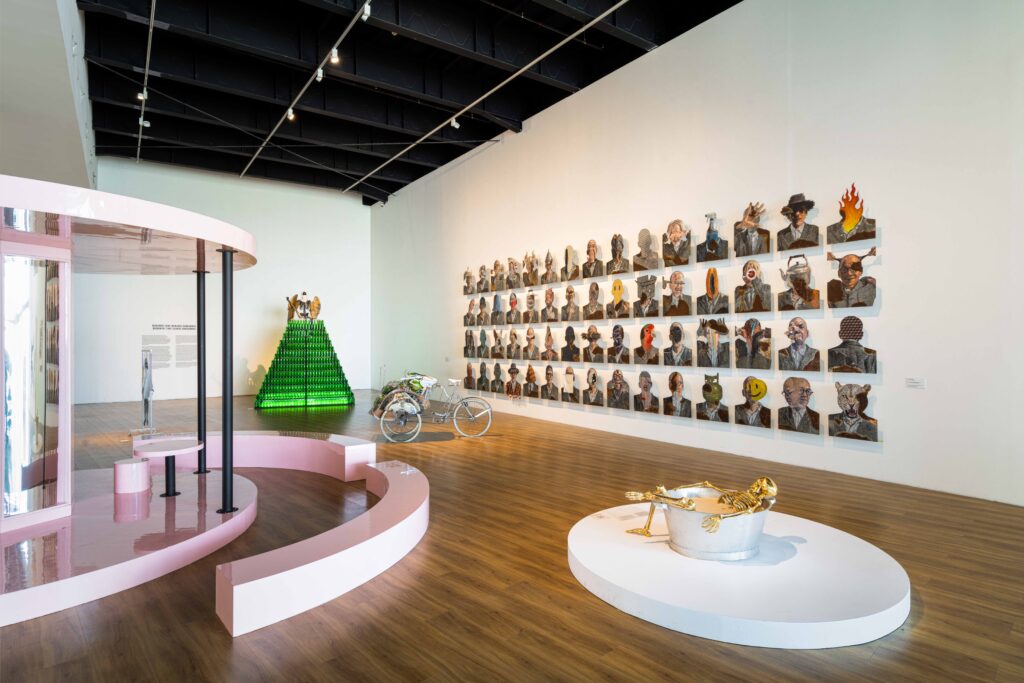

With over 80 works, the exhibition obviously has plenty to offer. It presents itself as a testimony and trajectory of the shifting times in Indonesia from the late 1990s to the present, through the personal reflections of Suwage. Based on this impressive overview one cannot but wonder about the artist’s future plans. In response to this question Suwage replies: “For me, I live happily and I believe that the work must be in accordance with the honesty of the heart and as naturally as possible, it will naturally come.”
ABOUT THE AUTHOR: SADIAH BOONSTRA
Dr Sadiah Boonstra is a Curator and Historian. She is Director of culturelab, a cultural consultancy in Jakarta, Indonesia. She is also a Research Associate at VU University Amsterdam and an Honorary Senior Fellow at the University of Melbourne. In her broad cultural practice Sadiah combines academic expertise with curation, public programming, producing, and teaching. Her professional and research interest focus on the arts, history, and heritage of Indonesia.

Share this article: